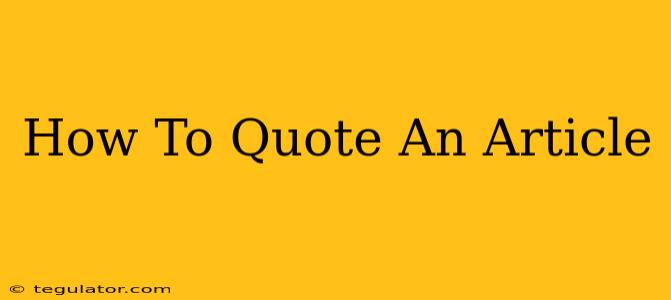Quoting an article correctly is crucial for academic integrity and effective communication. Whether you're writing a research paper, an essay, or simply referencing information for a blog post, understanding the nuances of quoting is essential. This guide provides a step-by-step approach to quoting articles accurately and avoiding plagiarism.
Understanding Different Quotation Styles
Several citation styles exist, each with its own specific rules for formatting quotes. The most common include:
- MLA (Modern Language Association): Primarily used in the humanities.
- APA (American Psychological Association): Commonly used in social sciences.
- Chicago/Turabian: Often used in history and other fields.
Choosing the correct style depends on your assignment guidelines or publication requirements. Failing to adhere to the specified style can result in penalties.
Key Differences Between Styles
While the core principles of quoting remain consistent across styles, the formatting details differ. For example:
- Placement of page numbers: Page numbers are typically included in parentheses at the end of the quote in MLA and APA styles, but their placement might vary in Chicago style.
- Use of quotation marks: While all styles utilize quotation marks for direct quotes, the use of single vs. double quotes can differ.
- In-text citations vs. footnotes/endnotes: Some styles favor in-text citations, while others utilize footnotes or endnotes for referencing sources.
How to Quote an Article: A Step-by-Step Guide
Regardless of the citation style, the process of quoting an article involves several key steps:
1. Identify the relevant passage: Carefully read the article and pinpoint the exact text you wish to quote. Avoid quoting excessively; only include the necessary information.
2. Copy the text accurately: Ensure you copy the passage precisely as it appears in the original source. Any alteration, including changing a word or punctuation mark, constitutes a misquotation and can be considered plagiarism.
3. Integrate the quote smoothly: Don't just drop the quote into your writing; introduce it with a signal phrase that sets the context and connects it to your argument. Examples include:
- "According to Smith (2023),"
- "As Jones argues,"
- "In their study, Brown and Davis found that..."
4. Use quotation marks: Enclose the quoted text within quotation marks. This clearly indicates that the words are not your own.
5. Provide an in-text citation: Immediately after the quote, include an in-text citation indicating the source. The specific format of this citation will depend on your chosen citation style. For example:
- MLA: (Author's Last Name Page Number)
- APA: (Author's Last Name, Year, Page Number)
6. Create a Works Cited/References page: At the end of your work, include a Works Cited page (MLA) or References page (APA) that provides complete bibliographic information for all sources cited, including the article you quoted.
Handling Long Quotes (Block Quotes)
For quotes exceeding four lines (MLA) or 40 words (APA), use a block quote. This involves:
- Indenting the entire quote from the left margin.
- Usually omitting quotation marks (though style guides may vary).
Avoiding Common Quoting Mistakes
- Over-quoting: Quote only essential information; paraphrase or summarize less crucial details.
- Misquoting: Always double-check the accuracy of your quote against the original source.
- Failing to cite: Proper citation is crucial to avoid plagiarism. Always cite your sources accurately and completely.
- Incorrect punctuation: Pay close attention to the punctuation within and around your quotes.
By following these guidelines, you can accurately quote articles and enhance the credibility and impact of your writing. Remember to consult your specific style guide for detailed instructions. Mastering the art of quoting is an essential skill for any writer, ensuring both academic integrity and strong communication.

